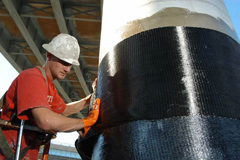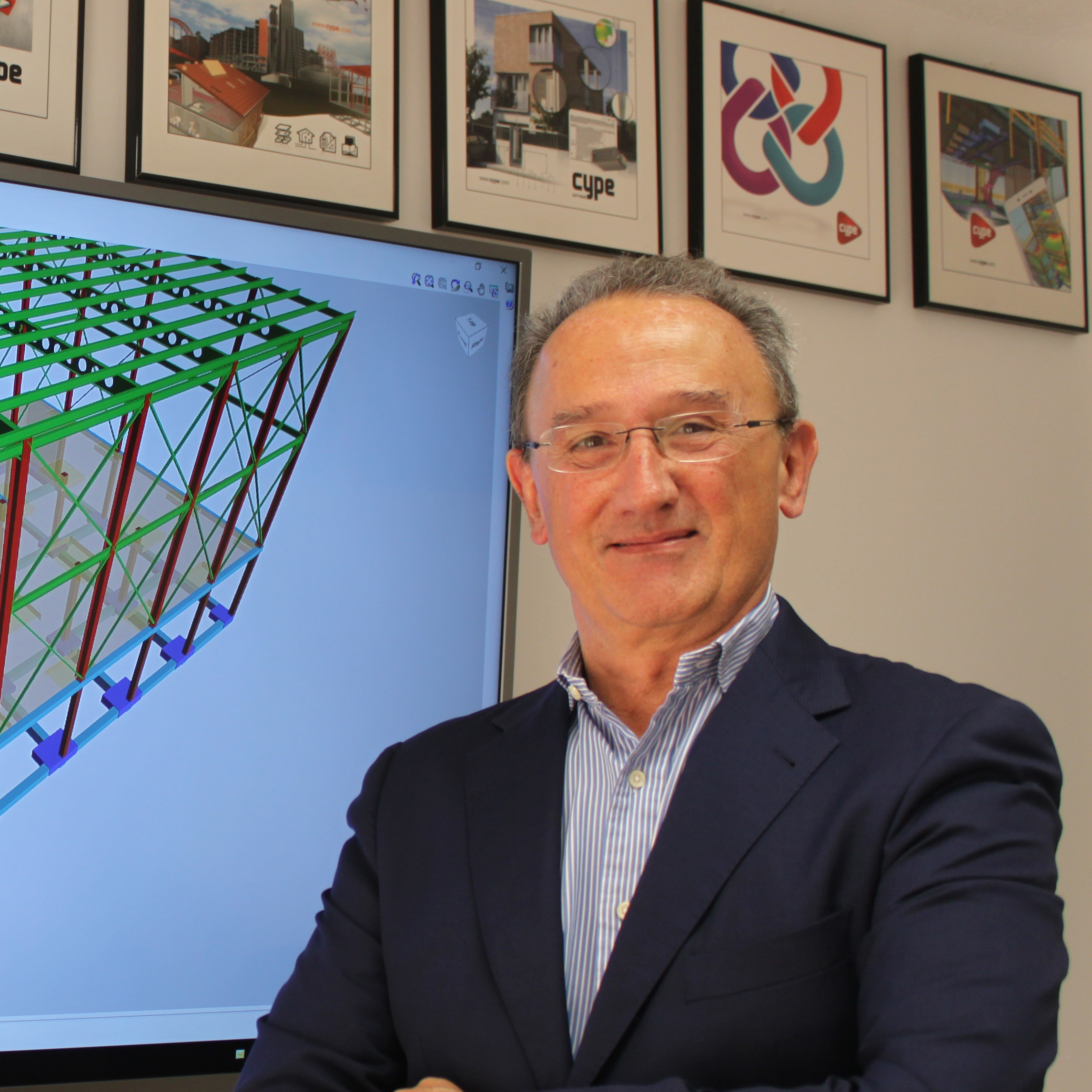CYPE, together with Sika®, a leading company in the development of chemical specialities for sealing, bonding, damping, reinforcing and protecting structures, have developed a software tool called Sika® CarboDur® Design Software that professionals can use to automatically design a structural reinforcement project using the different carbon fibre systems offered by the Swiss company, for specific international standards. We spoke to David Vázquez Cacho, Sika's International Technical Support Manager for the company's reinforcement systems with composites.
First of all, we would like to know what carbon fibre systems Sika® has developed.
It's a system based on a non-metallic composite that is three to five times lighter than rebar and eight to ten times stronger than steel. This means that its durability and high strength make it a highly qualified material to provide safety on construction sites and integrity to structures. They are, therefore, very lightweight systems often used as reinforcement systems to increase structural strength in any type of structural element, anything from a small building joist to a large dam.
How long has Sika® been developing this type of product?
Sika began developing its carbon reinforcement systems in the 1980s. This development was essentially carried out by Sika in Switzerland, with the collaboration of the Empa, the Swiss Federal Laboratories for Materials Science and Technology. Back then, the first developments were essentially based on the use of carbon fibre fabrics that were manually impregnated on the concrete surface using adhesives. This technique is still used today, although it has largely been replaced by simpler, safer and more effective prefabricated systems.
What was the main objective of this product at the time?
The objective of the first developments was essentially to come up with a solution that could overcome the durability problems detected in existing steel reinforcements. It was clear that many of the steel reinforcements carried out ten to fifteen years ago suffered serious corrosion problems at the time. For this reason, many engineers began to demand a solution without this limitation that could go far beyond the mechanical capabilities of steel.
How has this construction system evolved over the last few years in terms of innovation and improvements?
Throughout the 1990s, fabrics were gradually replaced by preformed carbon sheets, mainly in reinforcements aimed at increasing the bending resistance of concrete beams and slabs. This system based on prefabricated sheets allowed execution times to be drastically reduced, allowing work that would have taken several weeks using traditional reinforcement techniques to be planned in just a few days.
What about the turn of the 21st century?
New techniques have continued to emerge, such as using small carbon fibre bars or sections designed to be embedded in grooves in the concrete surface. This technique, called NSM (Near Surface Mounted), provided several benefits such as the carbon's ability to work under higher stress by reducing the risk of failure by uplift or buckling under compression.
Post-tensioning techniques were also developed, such as the Sika® CarboStress system. This technique not only allowed a significant increase in the ultimate strength of the reinforced element but also enabled the active correction of defects in the structure associated with its service conditions, such as deflections and cracking.
In recent years, techniques such as TRM (Textile Reinforced Mortar) have appeared, where synthetic adhesives have been replaced by cement mortars, and their use is mainly focused on reinforcing masonry elements.
“Technicians who use carbon as a rehabilitation system for the first time are often enthusiastic about it and will use it again due to its safety and simplicity”
What is Sika currently working on?
We are currently working on developments that aim to increase the performance of their CarboDur and SikaWrap carbon fibre systems by means of complementary anchoring systems or state-of-the-art structural adhesives that can increase the design deformations for the composite and thus reduce the reinforcement ratio to be applied.
Is this construction system used by a specific professional profile?
There is no predefined profile, as it is a reinforcement technique that can be used for both a residential slab and a large sea bridge. Specifically, in the Spanish market, it is a system widely used by a considerable number of engineers, architects and quantity surveyors due to the broad range of existing products and the many years of experience acquired. Technicians who use carbon as a rehabilitation system for the first time are often enthusiastic about it and will use it again due to its safety and simplicity.
Therefore, this technique is currently in use and is adopted by both small and large construction companies as it doesn't interfere with other construction processes or alter the geometrical conditions of the structure, envelopes or distribution elements.
What kind of projects is it typically used for?
On the one hand, it is worth highlighting the renovation of existing buildings, either due to their structure's degradation over time or to alterations in their load-bearing capacity. Its use in marine structures or buildings located near coastal areas is particularly noteworthy due to the corrosion risk faced by reinforcement systems with steel elements. In many cases, the job execution time is extremely short, so the use of carbon fibre may be the only viable alternative.

Could you provide any examples of the latter cases?
These may include sports stadiums, large shopping centres, car parks, bridges, industries and power generation plants, for example, where downtime is critical.
What about other types of projects?
Yes. In the European and North American markets, its use as a "commodity" or material commonly used in construction work is worth highlighting, as it allows structural problems that may arise from design errors or problems that could arise during construction, like reduced concrete stresses or problems with reinforcement installation or drilling holes in beams, to be corrected on the spot.
Has the number of projects with this construction system increased in recent years?
The use of carbon fibre reinforcement is widespread in mature markets such as Europe, Oceania and North America, where there are severe structural requirements. This means that it is often considered the first choice in many structural reinforcement projects, even ahead of traditional systems based on steel elements or concrete screeds.
Why do you think professionals choose this technology?
The reason for this is that they have been widely available in these countries for more than 20 years, and also because they are cheaper and take less time to install than other alternatives. This is taken into account both by professionals in the industry and by construction companies, who have been using carbon reinforcements extensively to solve a good number of minor problems that have arisen regularly during the construction of new buildings.
Do all countries use it the same way?
The uses are similar. A similar situation exists in Latin American countries, such as Mexico, Colombia, Argentina, Peru, etc., where the use of composites has also been widely accepted as a seismic reinforcement system of existing structures, as it allows the project to be carried out without affecting the existing geometry and volumes of buildings, car parks or bridges.
Other regions, especially the Middle East and Asia, mainly focus their use of carbon reinforcements on the rehabilitation of large infrastructures, such as skyscrapers, bridges or large shopping centres.
“The use of carbon fibre reinforcements in marine structures or buildings located near coastal areas is particularly noteworthy due to the corrosion risk faced by reinforcement systems with steel elements”
As the international manager of this product, which countries have the highest demand for carbon fibre systems?
Ten to fifteen years ago, the main buyers of carbon fibre reinforcement were Western Europe, Japan, the United States and certain Latin American countries such as Mexico, Chile and Colombia. Over the years, there has been a growing demand in new regions, mainly Asia and the Middle East. Nowadays, the demand continues to increase significantly at an international level, and it can be said that its use is widespread all over the world, except for parts of sub-Saharan Africa.
What advantages does the carbon fibre system offer over other systems such as the use of steel, concrete, etc.?
Technicians mainly highlight the impressive mechanical capabilities of CFRP systems and the high level of safety achieved by their use due to the minimal operator intervention and risk of errors during installation. Another factor they have highlighted is the safety in analyses, as there are already a large number of design guides that regulate their sizing according to the parameters of Eurocode 2 or ACI 318-14.
The owner of the structure has a structural reinforcement free of maintenance or degradation or corrosion problems, which can be installed in just a few hours or days. It should be noted that carbon reinforcement is approximately 1-2 millimetres thick, so it will disappear from view under simple plastering or rendering, without altering the rest of the building elements. This would be unthinkable with traditional reinforcement techniques based on steel sections or concrete screeds.
Some countries, such as Spain, don't have specific regulations for using this carbon fibre system for structures. Do you know if any specific regulations are being considered in Spain, and what is your opinion on the lack of these regulations in Spain?
Many countries have their own codes for the design of CFRP reinforcements: Canada, USA, Japan, Egypt, UK, Italy, Netherlands, and Germany, among others. In most cases, these design guides were developed ten to fifteen years ago and have been updated periodically.
Other countries, such as Spain, use international design guides, such as the fib (International Federation for Structural Concrete) bulletin 14, drafted in 2001, which will be updated in 2016. This guide is created as an annex to the European Eurocode 2, following the same design guidelines.
For European countries without their own standards, like Spain, it doesn't make sense to propose their own design code at this time. On the one hand, this is due to the existence of other perfectly usable international guides that follow European design patterns and, mainly, to the fact that the new update of Eurocode 2, scheduled for 2020, already includes the sizing of carbon fibre reinforcement.
For American and Asian countries, the main design guide is ACI 440.2R, which follows the same principles as the ACI 318 structural concrete standard.
Sika® and CYPE have a collaboration agreement for the development of a program that can design carbon fibre reinforcements in structures which, at present, complies with the North American ACI 440.R2-08, the Swiss standard SIA 166 and the British TR-55 standards. How can professionals benefit from such a tool?
In the late 1990s, the first design guidelines were only documents derived from experimental data obtained from laboratory tests. Therefore, it was barely feasible to introduce reinforcements beyond increasing the bending capacity of rectangular beams and the resistance of columns under centred loads. However, the main advantage was that the design could easily be carried out with pencil and paper in just a few minutes.
The guidelines for analysing carbon reinforcements have evolved exponentially over the last 15 years. This now makes it possible to enter sophisticated FRP systems for the reinforcement of an infinite number of construction elements under complex combinations of forces. However, many of these analyses are based on complex iteration and checking mechanisms, making their design practically impossible using spreadsheets, let alone manually.
This, together with the limited knowledge of engineers and architects on carbon fibre design guidelines, means that the main disadvantage for the designer is to carry out the design safely and easily. For this reason, Sika started to promote the use of analysis tools 15 years ago. The agreement with CYPE has allowed us to go further and Sika® is now able to provide its customers with the best software currently available worldwide for the specific design of carbon fibre reinforcements, free of charge.
“Sika® and CYPE have included a specific module in the software they have jointly developed, which includes the automatic calculation of the fire resistance of the different elements to be reinforced”
One of the problems that this construction system may have in comparison to other systems is its protection in the event of a fire. What kind of systems can be considered to improve safety in this area? Is it very different from other systems, such as the use of steel?
It's a common misconception that the loss of reinforcement as a result of an accidental action leads to the collapse of the structure. This is usually due to a lack of knowledge of the current concrete design codes regarding structural design in a fire situation among engineers and architects.
For this reason, it should be noted that the residual strength of the structural element in the event of a fire does not take the usual strength reduction factors for concrete and steel into account. Similarly, the combination of loads in the event of a fire is also regulated in the current reinforced concrete codes and is significantly lower than the usual design loads.
This makes reinforcement totally redundant in the vast majority of cases, making it unnecessary to consider any kind of action for their protection.
Therefore, in this situation, only passive protection of the reinforced concrete section (and not of the reinforcement) is to be expected in order to obtain a certain fire resistance, the design of which is usually carried out by means of the Isotherm 500 method indicated in the Spanish and European regulations.
In those rare situations where the carbon laminate must be protected, either specific protection mortars from the Sikacrete range or insulation panels can be used, much like the protection systems for steel plates.
Acknowledging the difficulties and the general lack of knowledge on this matter, Sika® and CYPE have included a specific module in the software they have jointly developed, which includes the automatic analysis of the fire resistance of the different elements to be reinforced.





